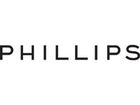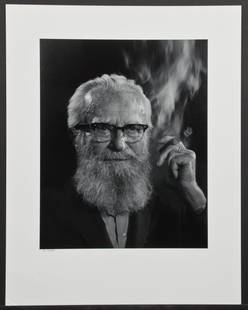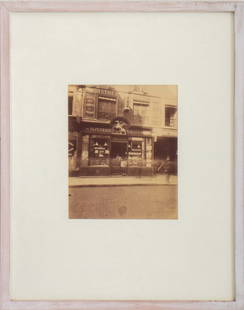
EDWARD STEICHEN, La Bella, 1904
Similar Sale History
View More Items in PhotographyRelated Photography
More Items in Photography
View More
Recommended Art
View More


Item Details
Description
La Bella, 1904. Platinum print. 9 3/4 x 9 1/4 in. (24.8 x 23.5 cm). Signed, decoratively titled and dated in roman numerals, all in wax pencil on the recto.
THE FACE OF MODERNISM: A PRIVATE WEST COAST COLLECTION
PROVENANCE From the artist; gifted to the sitter, Mercedes de Cordoba By descent to her daughter, Mercedes Matter Private Collection, New York
“I was coming to realize that the real magician was light itself—mysterious and ever-changing light with its accompanying shadows rich and full of mystery.”—Edward Steichen Edward Steichen’s artistic endeavors began in the late 1890s with painting and photography. The two mediums were linked by what Steichen termed as the “problems of expression…,” where capturing the mood was paramount to capturing reality. During that period, photography was still considered secondary to painting. Nonetheless, Steichen was adamant that the burgeoning photographic medium had the potential to gain widespread recognition as a valid art form, especially when rendered within the Pictorialist parameters. While still living in Milwaukee, Steichen produced a number of prints that corresponded to the Pictorial tenets. This was achieved in a number of ways, including wetting the lens, softening the focus and setting up a vibration during the exposure. In early works such as The Pool— Evening, 1899, and Woods—Twilight, 1899, as well as later ones, such as The Pond—Moonlight, 1904, Steichen created scenes that were gentle and lyrical, revealing his interest in photography not as a means to replicate reality but rather as a means to express mood and atmosphere. In 1901, eager to explore the European art movement, Steichen left for Paris and London. He felt an affinity with Pictorialism in Paris where he was inspired by the Impressionist works at The Musée du Louvre, particularly those by Claude Monet: “it seemed to me that he worked on canvas the way I tried to work with a camera.” And in London, Steichen met with the American publisher and photographer F. Holland Day, who was in the process of mounting an exhibition of what he termed the New School of American Photography at the Royal Photographic Society, for which he eagerly accepted ten of Steichen’s works. The London trip was of the utmost importance to Steichen’s career: not only did he find himself included among many of the leading American photographers of the time, but it was there that his interest in creating highly stylized, meditative portraits began. The majority of Steichen’s portraits made prior to his European trip, such as Self Portrait, 1898, Polly Horter, 1899, and Self Portrait with Sister, 1900, appear to have been shot outdoors, with the subjects’ faces in full view. However, following the trip to the Louvre, the exhibition in London and a subsequent year-long return to Paris, Steichen’s portraits took on a markedly different tone, one that was undeniably informed by Impressionist and Post- Impressionist portraiture, especially those by Rodin and Vincent Van Gogh. Steichen’s portraits taken in Paris, such as Solitude—F. Holland Day, 1901, Self Portrait with Brush and Palette, 1901, and Rodin—Le Penseur, 1902, were softer, more enigmatic, less frontal, and with far more nuanced lighting. Additionally, following his portrait of J.P. Morgan in 1903, Steichen realized that for a portrait to be successful it needed to transcend the self-consciousness that typify sitters and instead achieve to “awaken a genuine response.” In La Bella, 1904, Steichen beautifully expressed his love for nocturnal softness, delicate lighting and a seeming lack of awareness on the subject’s part. The subject, Mercedes de Cordoba, a Paris correspondent for Vogue and the future wife of Steichen’s friend and fellow artist at “291”, Arthur B. Carles, was a favored subject of a number of photographers due to her striking features. While Mercedes had been photographed previously by Steichen, the lighting was frontal and emphatic, distinctly illuminating her features. In the current lot, however, she is seen lit from behind; her features are soft. The fact that she is looking away from the lens creates a dreamlike effect that accentuates Steichen’s intent to evoke her ethereal and sensual qualities.
THE FACE OF MODERNISM: A PRIVATE WEST COAST COLLECTION
PROVENANCE From the artist; gifted to the sitter, Mercedes de Cordoba By descent to her daughter, Mercedes Matter Private Collection, New York
“I was coming to realize that the real magician was light itself—mysterious and ever-changing light with its accompanying shadows rich and full of mystery.”—Edward Steichen Edward Steichen’s artistic endeavors began in the late 1890s with painting and photography. The two mediums were linked by what Steichen termed as the “problems of expression…,” where capturing the mood was paramount to capturing reality. During that period, photography was still considered secondary to painting. Nonetheless, Steichen was adamant that the burgeoning photographic medium had the potential to gain widespread recognition as a valid art form, especially when rendered within the Pictorialist parameters. While still living in Milwaukee, Steichen produced a number of prints that corresponded to the Pictorial tenets. This was achieved in a number of ways, including wetting the lens, softening the focus and setting up a vibration during the exposure. In early works such as The Pool— Evening, 1899, and Woods—Twilight, 1899, as well as later ones, such as The Pond—Moonlight, 1904, Steichen created scenes that were gentle and lyrical, revealing his interest in photography not as a means to replicate reality but rather as a means to express mood and atmosphere. In 1901, eager to explore the European art movement, Steichen left for Paris and London. He felt an affinity with Pictorialism in Paris where he was inspired by the Impressionist works at The Musée du Louvre, particularly those by Claude Monet: “it seemed to me that he worked on canvas the way I tried to work with a camera.” And in London, Steichen met with the American publisher and photographer F. Holland Day, who was in the process of mounting an exhibition of what he termed the New School of American Photography at the Royal Photographic Society, for which he eagerly accepted ten of Steichen’s works. The London trip was of the utmost importance to Steichen’s career: not only did he find himself included among many of the leading American photographers of the time, but it was there that his interest in creating highly stylized, meditative portraits began. The majority of Steichen’s portraits made prior to his European trip, such as Self Portrait, 1898, Polly Horter, 1899, and Self Portrait with Sister, 1900, appear to have been shot outdoors, with the subjects’ faces in full view. However, following the trip to the Louvre, the exhibition in London and a subsequent year-long return to Paris, Steichen’s portraits took on a markedly different tone, one that was undeniably informed by Impressionist and Post- Impressionist portraiture, especially those by Rodin and Vincent Van Gogh. Steichen’s portraits taken in Paris, such as Solitude—F. Holland Day, 1901, Self Portrait with Brush and Palette, 1901, and Rodin—Le Penseur, 1902, were softer, more enigmatic, less frontal, and with far more nuanced lighting. Additionally, following his portrait of J.P. Morgan in 1903, Steichen realized that for a portrait to be successful it needed to transcend the self-consciousness that typify sitters and instead achieve to “awaken a genuine response.” In La Bella, 1904, Steichen beautifully expressed his love for nocturnal softness, delicate lighting and a seeming lack of awareness on the subject’s part. The subject, Mercedes de Cordoba, a Paris correspondent for Vogue and the future wife of Steichen’s friend and fellow artist at “291”, Arthur B. Carles, was a favored subject of a number of photographers due to her striking features. While Mercedes had been photographed previously by Steichen, the lighting was frontal and emphatic, distinctly illuminating her features. In the current lot, however, she is seen lit from behind; her features are soft. The fact that she is looking away from the lens creates a dreamlike effect that accentuates Steichen’s intent to evoke her ethereal and sensual qualities.
Buyer's Premium
- 25% up to $50,000.00
- 20% up to $1,000,000.00
- 12% above $1,000,000.00
EDWARD STEICHEN, La Bella, 1904
Estimate $60,000 - $80,000
1 bidder is watching this item.
Shipping & Pickup Options
Item located in New York, NY, usSee Policy for Shipping
Payment

Related Searches
TOP



























![EDWARD STEICHEN - Heavy Roses - Original warm-toned photogravure: Artist: Edward Steichen (American, 1879 - 1973). Title: "Heavy Roses [Voulangis, France]". Medium: Original warm-toned photogravure. Date: Composed 1914. Printed 1929. Dimensions: Overall siz](https://p1.liveauctioneers.com/963/236134/130671221_1_x.jpg?height=310&quality=70&version=1654900888)

![EDWARD STEICHEN - Wheelbarrow with Flower Pots - Original warm-toned vintage photogravure: Artist: Edward Steichen (American, 1879 - 1973). Title: "Wheelbarrow with Flower Pots [France]". Medium: Original warm-toned vintage photogravure. Date: Composed 1920. Printed 1929. Dimensions: <](https://p1.liveauctioneers.com/963/236135/130679718_1_x.jpg?height=310&quality=70&version=1654904341)




















![Guerre a la tristesse [SIGNED to FILM DIRECTOR ROBERTO ROSSELINI];Morath, Inga; Aubier, Dominique: SIGNED COPY Collection Neuf. Robert Delpire, Editeur, Paris, 1955. Hardcover in pictorial dust jacket. First French Edition, First Printing. 129 pages with numerous photographic images throughout. Tex](https://p1.liveauctioneers.com/8658/325945/175540251_1_x.jpg?height=310&quality=70&version=1712964944)


![[Custer, Little Big Horn] Eagle Elk, Oglala Sioux Warrior: “I was about 25 the summer we fought Long Hair and I still believed we could drive the white men from our country. I’m a little sad yet about that fight, although it was our finest victory.”](https://p1.liveauctioneers.com/7226/322253/173251540_1_x.jpg?height=310&quality=70&version=1710004847)

![[RE LEE] Signed Photograph & Letter To Namesake: ROBERT E. LEE WRITES TO CHILD NAMED AFTER HIM, ROBERT E. LEE JOHNSTON Autograph letter signed by Robert E. Lee, to Mary E. Johnston. Lexington, Virginia, 24 September 1867. 1 page, 8vo. Vingetted albu](https://p1.liveauctioneers.com/7226/325455/175169169_1_x.jpg?height=310&quality=70&version=1712370394)
![(2) Comanche Portraits by Lenny & Sawyers [Cabinet Card]: Two (2) Comanche cabinet cards: Ar-Ko, Captain Indian Police (Comanche). -- Comanche Alexander. Purcell: Indian Territory, n.d. Each titled in negative. Photographer's imprint to mount rectos. Pair of](https://p1.liveauctioneers.com/7226/322253/173251539_1_x.jpg?height=310&quality=70&version=1710004847)
























